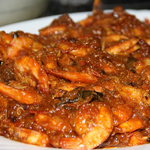 When I hear curry, I always think of Indian curry. And to tell you honestly, there had been a time when I thought that it’s the national food of the seventh largest country on the planet. But thanks to my job as a researcher, I’ve begun to learn Indian culture more. With over 20 states, each of which has its own sort of staple food, India sure has contributed a lot in the culinary world. And I found it fascinating that Indian food not only have curious names, which aren’t exactly easy to spell, but they also have a distinctly (for lack of a better term) Asian taste.
When I hear curry, I always think of Indian curry. And to tell you honestly, there had been a time when I thought that it’s the national food of the seventh largest country on the planet. But thanks to my job as a researcher, I’ve begun to learn Indian culture more. With over 20 states, each of which has its own sort of staple food, India sure has contributed a lot in the culinary world. And I found it fascinating that Indian food not only have curious names, which aren’t exactly easy to spell, but they also have a distinctly (for lack of a better term) Asian taste.
I learned that Indian dishes and ways of cooking vary from place to place. But it can be said that generally Indian dishes are spicy. Almost every recipe, be it for a main course dish or a drink, requires at least a pinch of spices and herbs. The best example would be, of course, the Indian curry, which is often eaten with some kind of flat bread. But, hey, curry and flatbread are not all there is to Indian cuisine. So, for those like me who are familiar with Indian cuisine as much as they are with Greek, I’ve listed down some of the most common Indian food; their names as well as their descriptions.
Hyderabad biryani – This is a dish made from basmati rice and goat meat. Though beef and pork can be used, goat meat is more popular because most Indians are Muslims and Hindus, and thus do not eat meat from cattle (considered sacred by Hindus) and pig (considered dirty by Muslims). Basmati rice is a long grain variety that is known for its distinct fragrance and taste. It’s also not that sticky compared to other rice grain varieties when cooked.
Roti and chapatti – These are types of flat bread made from finely milled flour. They don’t have any yeast or baking powder, but they are made with a little oil or ghee (purified or clarified butter) to make them pliable just like the Mexican soft tortilla. They are usually eaten with curries and vegetables. But unlike with a tortilla, you don’t wrap it around the filling. You simply have to fold the roti or chapati such that it creates a scoop at one end with which you can spoon the curry.
Rogan josh – Taken from a Persian phrase meaning “cooked in oil”, this dish is just one of the many varieties of Indian curry. It includes lamb meat, oil or ghee, and different spices, such as paprika, cardamom, cumin, cinnamon, and cloves, which give the dish a red color and an exquisite spicy aroma.
Samosa – A very popular snack in India , samosa is also eaten in many other parts of Asia and even in western countries. Samosa is what would otherwise be called fried dumpling in other parts of the world. Samosas in India , however, are usually triangular in shape. Its stuffing includes mashed potatoes, chili, onion, coriander, cumin seeds, and sometimes meat and paneer (Indian version of white cheese).
Masala dosa – To westerners, this is crepe. Just like crepes, the masala dosa is cooked on a griddle or flat pan. The only difference is that its batter is made from rice and urad dal (a type of lentil) pastes. It may be wrapped around a filling, forming a triangle like a quesadilla, or it may be eaten with any kind of chutney (Indian sauce or salsa made from spices, herbs, fruits, and vinegar).
These are just some of the most popular Indian dishes. While they say that Indian cuisine appreciation depends on one’s taste, but I guarantee, if you learn Indian style food preparation, you’ll definitely appreciate them even more.